How To Start, Germinate and Care for Seeds
How to start seeds, germinate, grow, and care for them is a gardener’s life skill. Many plants and vegetables fare better when started indoors before the ground warms up. We’ll go over some of the most common (and successful) ways to start seeds both indoors and out, as well as give our favorite tools for the job.
Why Start Seeds Indoors?
Before proceedign with your seeds, you might want to test the viability of your seeds.
Even though you may be successful direct sowing wildflower seed, there are a variety of reasons why it makes sense to start seeds indoors:
- You can control the environment of your seed germination by maintaining a certain temperature, keeping the trays in a sunny spot, and covering them to help with humidity and warmth.
- You can get a jumpstart on the growing season! This is helpful in colder areas where the growing season is short. Instead of planting your seeds directly in the soil at the end of May, you can transplant already-established seedlings at the same time and enjoy blooms that much earlier. This is also the secret behind growing plants that require a longer season than your climate can give them.
Succession Planting
- You can utilize succession planting. If you’re growing varieties like Zinnias and want a longer bloom period, if you start some weeks before planting time and then direct sow more seeds once there’s no more chance of frost, this will make sure you’ll have Zinnia blooms all season long.
- It’s much cheaper than buying plants at the garden center. Many sought-after annual varieties like Amaranth and Alyssum can be costly if bought as plugs at the garden center. It’s so easy to grow your own starts and fill in your garden and containers at a fraction of the cost!
Direct Sow v. Starting
There are some seeds that are recommended to start indoors, including smaller seeds and those that need a little extra heat to germinate. Smaller seeds often need to be ‘thinned’ after they sprout, which is a much easier task indoors at the table then it is outside on your hands and knees. Larger seeds and those with fragile root systems should be sown directly in the ground. There are a few varieties that can be started indoors for earlier blooms or directly sown, it just depends on your preference: Direct Sow:
Start Indoors:
Direct Sow Or Start Indoors, depending on your preference:
Our Favorite Tools to Start Seeds
There are so many tools available to help with seed starting, althought the majority of them are unnecessary for the resourceful gardener. All you really need is a good vessel to plant the seeds, good seed-starting or germinating mix, and a warm, sunny spot.
That being said, here are some of our favorite tools to successfully start flowers from seed. From left to right, different pots to use for starting seeds:
- plastic cell packs,
- peat pots,
- egg cartons,
- newspaper pots,
- soil blockers.
Good seed starting soil, a trowel, and a spray bottle are also very helpful when starting seeds.
Tools To Plant The Seeds:
- Flat Trays – This is the bottom tray that holds your cell packs, but can also be filled with soil to start seeds. After sprouts appear and grow, you can use a fork, spoon, or popsicle stick to remove and transplant seedlings.
- Cell Packs – These usually come 4/6 cells per pack and roughly 8 packs can fit in a standard flat tray.
- Peat Pots – These are great for varieties with fragile roots, like milkweed, as you can plant the entire biodegradable pot directly into the ground without disturbing the root system.
- Soil Blockers – A small metal tool that makes it easy to create cells simply out of moist soil.
- Newspaper Pots – Use one sheet of newspaper per pot and fold lengthwise twice. Roll around a can and then fold over the top to make the base. Slide the can out, fill the pot with seed starting soil, and you’re ready to go! These pots can also be planted directly in the ground when it’s time to plant.
- Egg Cartons – If you have extra egg cartons laying around, each cell can start one seed! When it’s time to plant, cut the cells apart and plant directly in the ground.
- Seed Starting Mix – This is a special, finely-screened mix to help seeds germinate and grow healthy roots. You can use just this to start seeds, or layer potting soil (which is less expensive) in the bottom half of your cells and fill the rest with seed starting mix. Using potting soil on its own often brings mixed results, as it typically includes larger material, such as bark and wood that can block small roots from making contact with actual soil particles – their source of nurtients.

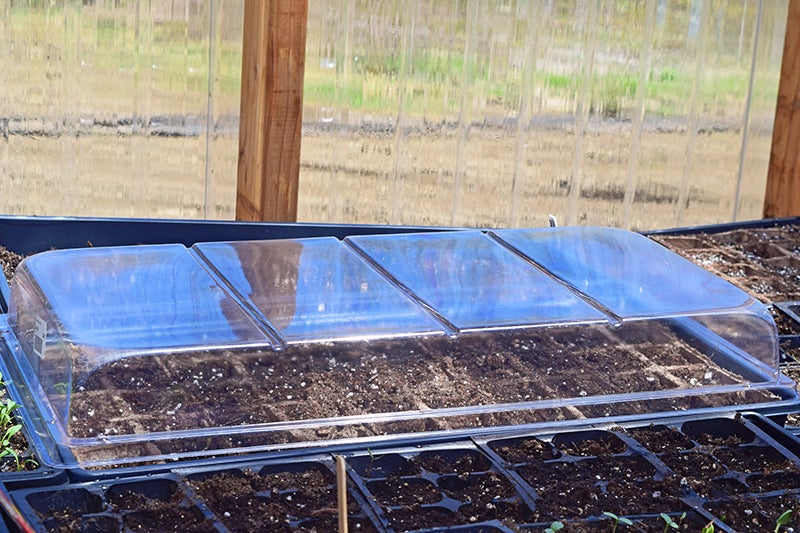
Tools To Help With Germination:
- Plastic Dome – Plastic domes can be purchased at your local garden center and help add humidity and trap heat in to help the seedlings germinate. Once you see sprouts emerge, remove the dome so that tender young seedlings don’t overheat.
- Saran Wrap – Saran wrap can be used the same as plastic domes and can be laid out directly on top of your trays. Again, once seedlings emerge you should remove the saran wrap.
- Heat Mat – Heat mats can be found online and help speed up germination. Place your trays on top of the heat mat until seedlings emerge. Alternatively, place your trays on top of your refrigerator or radiator to provide heat from below. Once seedlings emerge, make sure the trays are moved to a spot with direct sunlight.
- Spray Bottle – Although all of your seedlings should be watered from below (which is why the tray comes in handy), spraying the soil from above with a spray bottle also helps. A spray bottle is gentle enough that it won’t damage the fragile seedlings.
- Grow Lights – If you don’t have a spot in your home with direct sunlight to place your seed trays, a standard grow light purchased at your garden center or online works great.
- Thermometer – Temperature is a key element for germination. This is extremely helpful to determine the temperature in the room where you’re starting your seeds. Most seeds require temperatures no cooler than 65 degrees to geminate.
Best Method For Planting and Germination
Although there are many different tools for sowing seeds, the method is pretty much the same for every gardener:

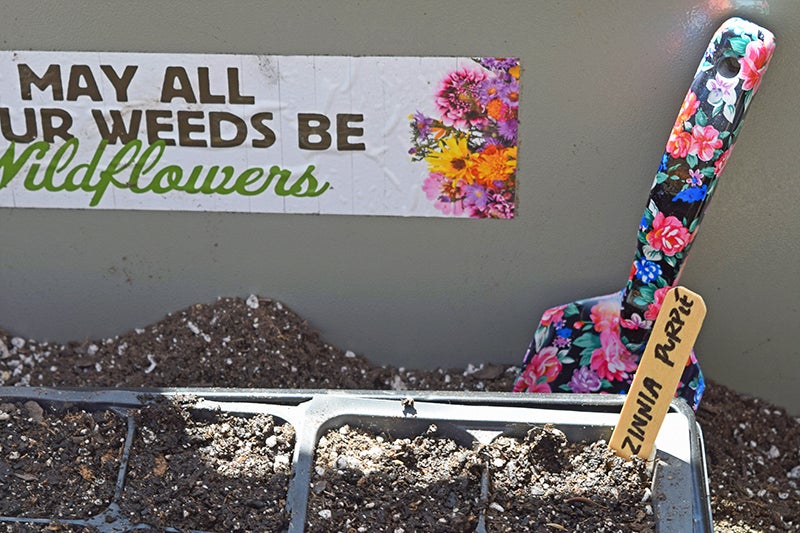
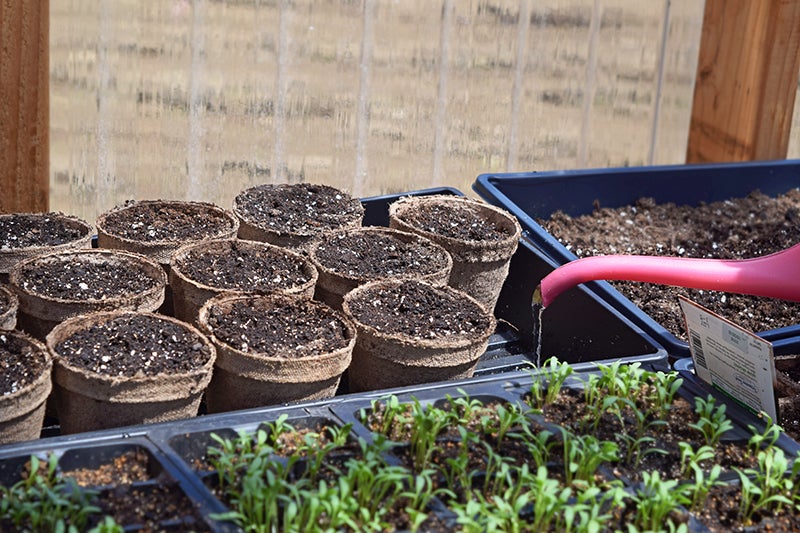
- Look at your last frost date in your area.
- Confirm the recommended number of weeks before sowing your seeds. Hard shells seeds may need to be scarified or soaked before planting.
- Find a warm, sunny spot indoors as the perfect place to place your trays. Or, use a grow light positioned close (within 6 inches) of your seedlings so that they remain short and stout. You’ll need to move your light source frequently as plants begin to grow.
- Add water to your soil and mix it with your hands. You want the soil to be moist enough that it can be formed into a ball. But not too wet that it isn’t solid. If you don’t pre-wet the soil mix, water may simply run off the top and doesn’t soak in.
- Place your soil in your cells (plastic, peat, newspaper, or egg carton). Pack the soil down with your fingers. Add more, and pack it down again until it comes almost to the top of your cell.
- Put your seeds on a small dish to easily pick one up at a time.
- Plant your seeds to their recommended depth. Often, seeds are placed on top of the soil covered with a light dusting. We recommend planting two seeds per cell. This ensures you’ll at least have one seed germinate. You can remove the weaker seedling once they are an inch high.
- Water from below into the tray. The holes in the bottom of each cell will allow the plant roots to wick up water as needed.
- Add a plant marker to the tray so you don’t get your varieties mixed up. You can use popsicle sticks or wooden markers you can find at the garden center.
- Cover with a plastic dome or saran wrap to help speed up germination.
- Place on a heat mat, or on top of your refrigerator, or in a warm area of your home.
Growing and Caring For Seedlings
Once you’ve planted, be sure to check your trays each day to ensure they are moist enough. You’ll want to water from below every day (or every other day) depending on how quickly your soil dries. Once your seedlings emerge, remember to remove the plastic dome or saran wrap. Care for the seedlings by watering below when necessary and use a spray bottle to mist the tops. If you have two seedlings growing in one cell, once they are about an inch tall you can remove the weaker (smaller) one by either gently pinching at the base of the stem or snipping with a small pair of scissors. Your goal is to leave the roots of the seedling you plan to keep undisturbed, in case the roots of both plants are intertwined below the soil. This is an important step to make sure the remaining seedling has plenty of room to grow healthy roots.
Once your seeds sprout and two seedlings emerge in one cell, gently use your fingers to remove the weakest one.
One of the most common problems with starting seeds is legginess. You can tell if your seeds are leggy if they are extremely thin and growing taller faster than they are filling out. Leggy seedlings are often extremely fragile and need extra care. The biggest cause of legginess is lack of direct sunlight, so if you’re noticing your seeds are looking leggy, make sure to move them to a sunnier spot or add another grow light to your setup. Leggy seedlings can usually grow into healthy plants, but you will want to give them as much sunlight and TLC as possible.
How To Start Seeds: Planting Outdoors
Once there is no more danger of frost in your area, it’s time to plant your seedlings outdoors! Whether you’re planting in containers or directly in the ground, you’ll still want to make sure there is no more chance of frost in your area.
One of the most important steps to ensuring your seedlings grow into healthy plants outdoors is to harden them off before you plant them. Hardening off is a gradual process where you acclimate your seedlings into the harsher sunlight and temperatures outdoors so they don’t get shocked from the different growing conditions:
Use a wheelbarrow or garden cart to harden off your seeds, bringing them outdoors for a few hours each day to get acclimated to outdoor temperatures.
How to Harden Your Plant Seedlings Outdoors
- Starting with a mild day, bring your seedlings outside into dappled sunlight for 2-3 hours. Protect them from harsh sun, cold temperatures, and extreme wind.
- Each day for about a week you can add one more hours to the time your seedlings spend outdoors, while also gradually watering them less.
- After about a week of this, make sure you choose a mild day to plant your seedlings outdoors.
- Dig a hole about the size of your cell and make sure to plant the seedling at the same depth as it is in the cell.
- Apply a watered-down solution of organic fertilizer to your new plantings.
- Water thoroughly.
Once acclimated, seedlings will start to take off in your garden beds or containers! Remember to keep the new plants watered regularly and keep an eye on them for the first few weeks. Once you’ve started seeds once, you’ll get the hang of it and many of your tools (including plastic trays, cells, and domes) can be used year after year. Simply wash them in a diluted water/bleach solution to disinfect before planting the next season.







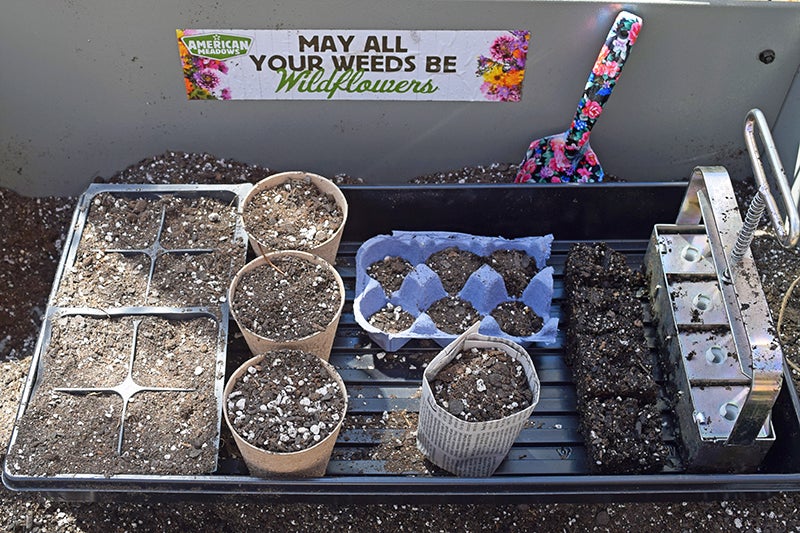

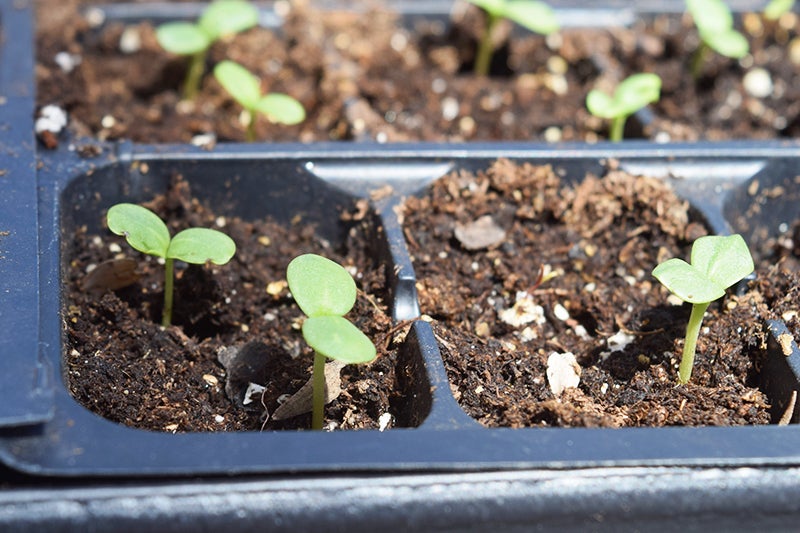

Leave a Reply
You must be logged in to post a comment.